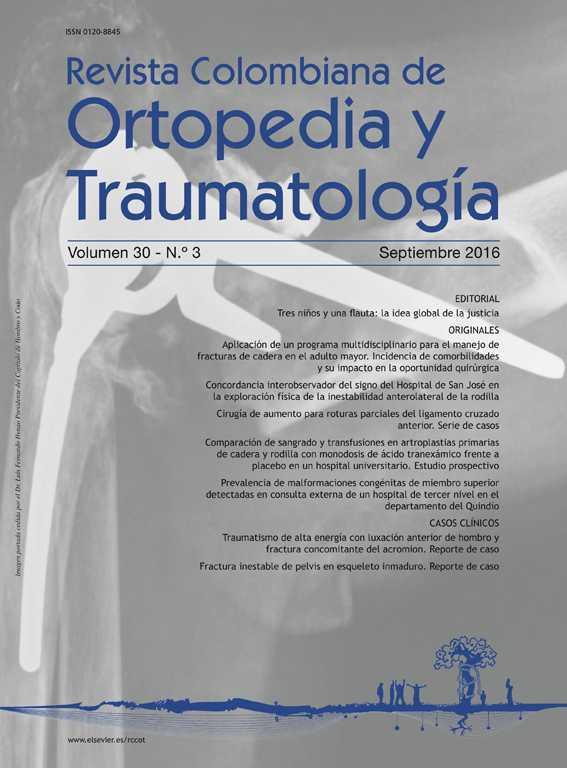Cirugía de aumento para roturas parciales del ligamento cruzado anterior. Serie de casos
DOI:
https://doi.org/10.1016/j.rccot.2016.10.008Palabras clave:
ligamento cruzado anterior, aumento, roturaResumen
Introducción: Las roturas del ligamento cruzado anterior (LCA) son cada vez más frecuentes y no es raro encontrar pacientes con roturas parciales. Teniendo en cuenta que no hay nada mejor que un ligamento originario, aún no está claro si es útil preservar el haz íntegro del LCA o reconstruir solo el lesionado.
Materiales y métodos: La cohorte prospectiva descriptiva incluyó a pacientes con cirugía de aumento del LCA entre 2008 y 2012 en el Hospital de San José de Bogotá. Se excluyó a aquellos pacientes con patología asociada en cualquier rodilla, con enfermedad inflamatoria articular de base y con artrosis moderada. Se realizó un seguimiento a 2 años postoperatorios con pruebas clínicas y funcionales.
Resultados: Once pacientes incluidos, con una media de edad de 36 años finalizaron el seguimiento. La mayoría eran hombres (8/11). El haz comprometido y el autoinjerto utilizado fueron en el 100% de los casos el posterolateral y hueso-tendón rotuliano-hueso, respectivamente. En la exploración física hubo mejoras en cuanto a las pruebas de Lachman, de desplazamiento del pivote y en el KT-1000. En la escala funcional KOOS (Knee injury and Osteoarthritis Outcome Score) se encontraron mejores puntuaciones medias en las categorías de funcionamiento en actividades cotidianas (87) y dolor (78).
Discusión: El aumento del ligamento cruzado anterior a medio plazo (2 años)ofrece resultados favorables, tanto clínicos como funcionales, similares a los resultados de reconstrucción estándar reportados en la bibliografía.
Nivel de evidencia clínica: Nivel IV.
Descargas
Referencias bibliográficas
Demirağ B, Ermutlu C, Aydemir F, Durak K. A comparison of clinical outcome of augmentation and standard reconstruction techniques for partial anterior cruciate ligament tears. Eklem Hastalik Cerrahisi. 2012;23:140-4.
Yasuda K, Kondo E, Kitamura N, Kawaguchi Y, Kai S, Tanabe Y. A pilot study of anatomic double-bundle anterior cruciate ligament reconstruction with ligament remnant tissue preservation. Arthroscopy. 2012;28:343-53. https://doi.org/10.1016/j.arthro.2011.08.305
Song GY, Zhang J, Li X, Chen XZ, Li Y, Feng H. Acute anterior cruciate ligament reconstruction with an augmented remnant repair: a comparative macroscopic and biomechanical study in an animal model. Arthroscopy. 2014;30:344-51. https://doi.org/10.1016/j.arthro.2013.11.030
Van Dyck P, De Smet E, Veryser J, Lambrecht V, Gielen JL, Vanhoenacker FM, et al. Partial tear of the anterior cruciate ligament of the knee: injury patterns on MR imaging. Knee Surg Sports Traumatol Arthrosc. 2012;20:256-61. https://doi.org/10.1007/s00167-011-1617-7
Borbon CA, Mouzopoulos G, Siebold R. Why perform an ACL augmentation? Knee Surg Sports Traumatol Arthrosc. 2012;20:245-51. https://doi.org/10.1007/s00167-011-1565-2
Siebold R, Fu FH. Assessment and augmentation of symptomatic anteromedial or posterolateral bundle tears of the anterior cruciate ligament. Arthroscopy. 2008;24:1289-98. https://doi.org/10.1016/j.arthro.2008.06.016
Ochi M, Adachi N, Uchio Y, Deie M, Kumahashi N, Ishikawa M, et al. A minimum 2-year follow-up after selective anteromedial or posterolateral bundle anterior cruciate ligament reconstruction. Arthroscopy. 2009;25:117-22. https://doi.org/10.1016/j.arthro.2008.10.011
Noyes FR, Mooar LA, Moorman CT, McGinniss GH. Partial tears of the anterior cruciate ligament. Progression to complete ligament deficiency. J Bone Joint Surg Br. 1989;71:825-33. https://doi.org/10.1302/0301-620X.71B5.2584255
Bicer EK, Lustig S, Servien E, Selmi TA, Neyret P. Current knowledge in the anatomy of the human anterior cruciate ligament. Knee Surg Sports Traumatol Arthrosc. 2010;18:1075-84. https://doi.org/10.1007/s00167-009-0993-8
Liljedahl SO, Lindvall N, Wetterfors J. Early diagnosis and treatment of acute ruptures of the anterior cruciate ligament; a clinical and arthrographic study of forty-eight cases. J Bone Joint Surg Am. 1965;47:1503-13. https://doi.org/10.2106/00004623-196547080-00004
Kazusa H, Nakamae A, Ochi M. Augmentation technique for anterior cruciate ligament injury. Clin Sports Med. 2013;32:127-40. https://doi.org/10.1016/j.csm.2012.08.012
Fruensgaard S, Johannsen HV. Incomplete ruptures of the anterior cruciate ligament. J Bone Joint Surg Br. 1989;71:526-30. https://doi.org/10.1302/0301-620X.71B3.2722951
Danylchuk KD, Finlay JB, Krcek JP. Microstructural organization of human and bovine cruciate ligaments. Clin Orthop Relat Res. 1978;29:4-8. https://doi.org/10.1097/00003086-197803000-00048
Park SY, Oh H, Park SW, Lee JH, Lee SH, Yoon KH. Clinical outcomes of remnant-preserving augmentation versus double-bundle reconstruction in the anterior cruciate ligament reconstruction. Arthroscopy. 2012;28:1833-41. https://doi.org/10.1016/j.arthro.2012.05.886
Xu Y, Liu J, Kramer S, Martins C, Kato Y, Linde-Rosen M, et al. Comparison of in situ forces and knee kinematics in anteromedial and high anteromedial bundle augmentation for partially ruptured anterior cruciate ligament. Am J Sports Med. 2011;39:272-8. https://doi.org/10.1177/0363546510383479
Ohsawa T, Kimura M, Kobayashi Y, Hagiwara K, Yorifuji H, Takagishi K. Arthroscopic evaluation of preserved ligament remnant after selective anteromedial or posterolateral bundle anterior cruciate ligament reconstruction. Arthroscopy. 2012;28:807-17. https://doi.org/10.1016/j.arthro.2011.11.033
Jung YB, Jung HJ, Siti HT, Lee YS, Lee HJ, Lee SH, et al. Comparison of anterior cruciate ligament reconstruction with preservation only versus remnant tensioning technique. Arthroscopy. 2011;27:1252-8. https://doi.org/10.1016/j.arthro.2011.05.013
Lee BI, Min KD, Choi HS, Kwon SW, Chun DI, Yun ES, et al. Immunohistochemical study of mechanoreceptors in the tibial remnant of the ruptured anterior cruciate ligament in human knees. Knee Surg Sports Traumatol Arthrosc. 2009;17:1095-101. https://doi.org/10.1007/s00167-009-0831-z
Dhillon MS, Bali K, Vasistha RK. Immunohistological evaluation of proprioceptive potential of the residual stump of injured anterior cruciate ligaments (ACL). Int Orthop. 2010;34:737-41. https://doi.org/10.1007/s00264-009-0948-1
Wu B, Zhao Z, Li S, Sun L. Preservation of remnant attachment improves graft healing in a rabbit model of anterior cruciate ligament reconstruction. Arthroscopy. 2013;29:1362-71. https://doi.org/10.1016/j.arthro.2013.05.010
Song GY, Zhang H, Zhang J, Li X, Chen XZ, Li Y, et al. The anterior cruciate ligament remnant: to leave it or not. Arthroscopy. 2013;29:1253-62. https://doi.org/10.1016/j.arthro.2013.03.078
Papalia R, Franceschi F, Vasta S, Di Martino A, Maffulli N, Denaro V. Sparing the anterior cruciate ligament remnant: is it worth the hassle. Br Med Bull. 2012;104:91-111. https://doi.org/10.1093/bmb/ldr053
Adachi N, Ochi M, Uchio Y, Iwasa J, Ryoke K, Kuriwaka M. Mechanoreceptors in the anterior cruciate ligament contribute to the joint position sense. Acta Orthop Scand. 2002;73:330-4. https://doi.org/10.1080/000164702320155356
Sonnery-Cottet B, Lavoie F, Ogassawara R, Scussiato RG, Kidder JF, Chambat P. Selective anteromedial bundle reconstruction in partial ACL tears: a series of 36 patients with mean 24 months follow-up. Knee Surg Sports Traumatol Arthrosc. 2010;18: 47-51. https://doi.org/10.1007/s00167-009-0855-4
Ahn JH, Wang JH, Lee YS, Kim JG, Kang JH, Koh KH. Anterior cruciate ligament reconstruction using remnant preservation and a femoral tensioning technique: clinical and magnetic resonance imaging results. Arthroscopy. 2011;27:1079-89. https://doi.org/10.1016/j.arthro.2011.03.002
Buda R, Ferruzzi A, Vannini F, Zambelli L, Di Caprio F. Augmentation technique with semitendinosus and gracilis tendons in chronic partial lesions of the ACL: clinical and arthrometric analysis. Knee Surg Sports Traumatol Arthrosc. 2006;14: 1101-7. https://doi.org/10.1007/s00167-006-0117-7
Mifune Y, Ota S, Takayama K, Hoshino Y, Matsumoto T, Kuroda R, et al. Therapeutic advantage in selective ligament augmentation for partial tears of the anterior cruciate ligament: results in an animal model. Am J Sports Med. 2013;41:365-73. https://doi.org/10.1177/0363546512471614
Chouteau J, Testa R, Viste A, Moyen B. Knee rotational laxity and proprioceptive function 2 years after partial ACL reconstruction. Knee Surg Sports Traumatol Arthrosc. 2012;20:762-6. https://doi.org/10.1007/s00167-012-1879-8
Papalia R, Franceschi F, Zampogna B, Tecame A, Maffulli N, Denaro V. Surgical management of partial tears of the anterior cruciate ligament. Knee Surg Sports Traumatol Arthrosc. 2014;22:154-65. https://doi.org/10.1007/s00167-012-2339-1
Irrgang JJ. Current status of measuring clinical outcomes after anterior cruciate ligament reconstruction: Are we good enough. Oper Techn Sport Med. 2008;16:119-24. https://doi.org/10.1053/j.otsm.2008.10.013
Hambly K, Griva K. IKDC or KOOS: which one captures symptoms and disabilities most important to patients who have undergone initial anterior cruciate ligament reconstruction. Am J Sports Med. 2010;38:1395-404. https://doi.org/10.1177/0363546509359678
Salavati M, Akhbari B, Mohammadi F, Mazaheri M, Khorrami M. Knee injury and Osteoarthritis Outcome Score (KOOS); reliability and validity in competitive athletes after anterior cruciate ligament reconstruction. Osteoarthritis Cartilage. 2011;19:406-10. https://doi.org/10.1016/j.joca.2011.01.010
Paradowski PT, Witoński D, Kęska R, Roos EM. Cross-cultural translation and measurement properties of the Polish version of the Knee injury and Osteoarthritis Outcome Score (KOOS) following anterior cruciate ligament reconstruction. Health Qual Life Outcomes. 2013;11:107. https://doi.org/10.1186/1477-7525-11-107
Descargas
Publicado
Cómo citar
Número
Sección
Licencia
Derechos de autor 2024 Revista Colombiana de ortopedia y traumatología

Esta obra está bajo una licencia Creative Commons Reconocimiento 3.0 Unported.








